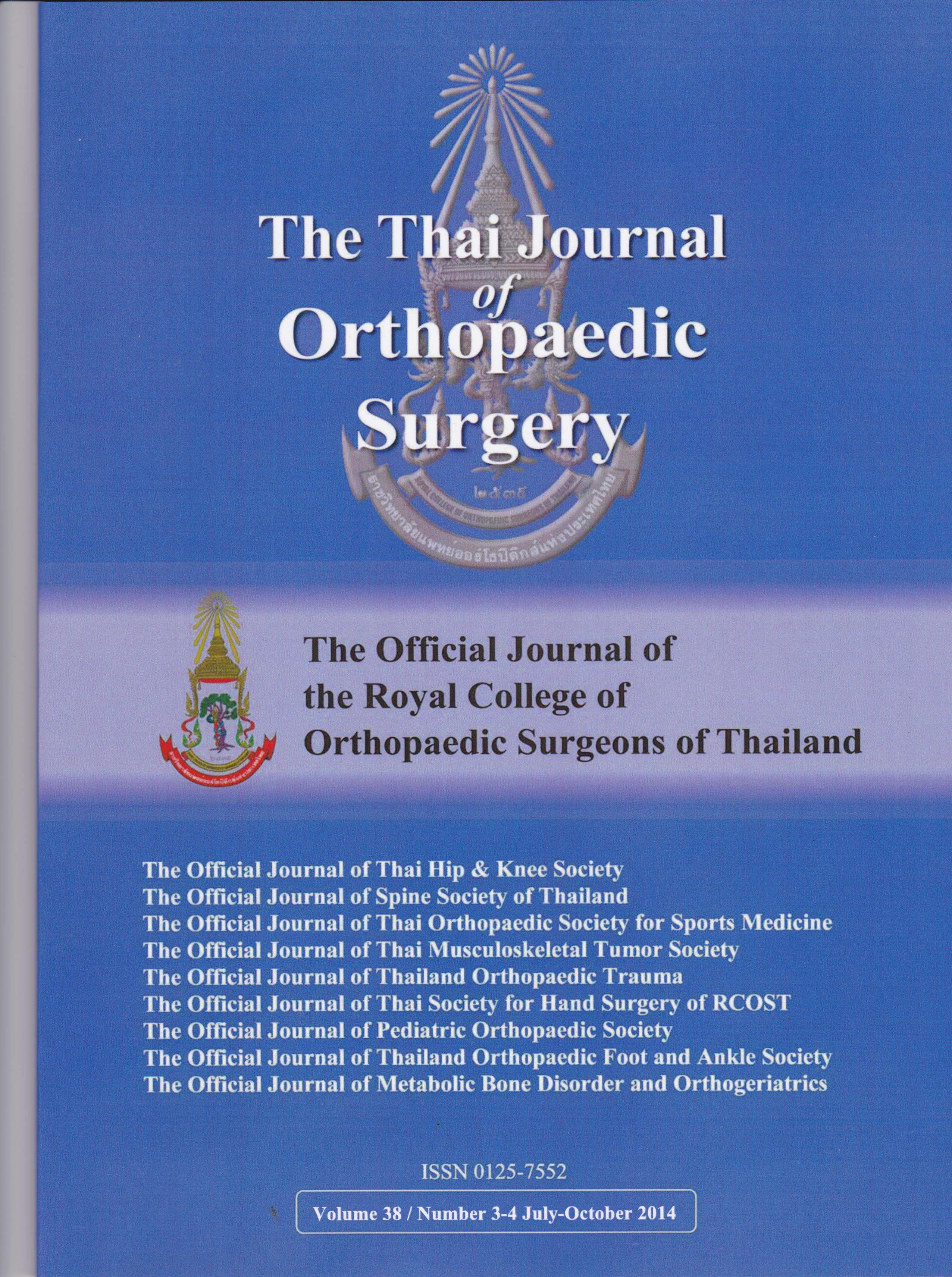Serum CRP and ESR Values do not Correlate with Clinical and Radiographic Severity of Knee Osteoarthritis
Main Article Content
Abstract
Purpose: Low levels of inflammatory markers in osteoarthritis can now be detected with modern laboratory tests. We questioned whether inflammatory markers are higher in patients with more severe knee osteoarthritis, such as those with significant radiographic joint attrition or who require total knee arthroplasty.
Methods: A cross-sectional study of serum C-reactive protein (CRP) and erythrocyte sedimentation rate (ESR) values in knee osteoarthritis patients with various clinical and radiographic severities was performed. The diagnosis of knee osteoarthritis was made according to the criteria of the American College of Rheumatology. For clinical severity, comparison was made between patients who were satisfied with conservative treatment and those who were scheduled for total knee arthroplasty (TKA) due to inadequate improvement. Radiographic severity was graded by the Ahlbäck classification and whether the involved compartments were joint-sparing or bone-on-bone.
Results: One-hundred and ten patients were included in our study. There were 54 patients with a mean age of 69.4 years in the conservative group and 56 patients with a mean age of 68.2 years in the pre-TKA group. Serum CRP was higher in patients who were scheduled for TKA than out patient department (OPD) patients, but this difference was not statistically significant (6.4±7.4 mg/L vs 3.6±1.0 mg/L; P=0.80). Serum ESR of the two groups were also not significantly different (26.8±16.9 mm/hr vs 23.0±16.4mm/hr; P=0.17 ). Neither serum levels of CRP nor ESR were significantly different when patients were categorized by the Ahlbäck classification (P=0.20 and 0.83, respectively) or divided into joint-sparing and bone-on-bone groups (P=0.65 and 0.37 for CRP and ESR, respectively)
Conclusion: Elevation of serum CRP and ESR represent the body’s response to an inflammatory condition and should correspond well to the level of joint inflammation. However, the current study did not find significant relationships between CRP and ESR and clinical or radiographic severity of knee osteoarthritis. A possible explanation is that there are several factors other than inflammation that contribute to the severity of knee osteoarthritis such as pain, deformity, and instability.
Article Details
References
2. Keenan RT, Swearingen CJ, Yazici Y. Erythrocyte sedimentation rate and C-reactive protein levels are poorly correlated with clinical measures of disease activity in rheumatoid arthritis, systemic lupus erythematosus and osteoarthritis patients. Clin Exp Rheumatol 2008; 26: 814-9.
3. Pearle A, Scanzello C, George S, Mandl L, Dicarlo E, Peterson M, et al. Elevated high-sensitivity C-reactive protein levels are associated with local inflammatory findings in patients with osteoarthritis. Osteoarthritis and Cartilage 2007; 15: 516-23.
4. Takahashi M, Naito K, Abe M, Sawada T, Nagano A. Relationship between radiographic grading of osteoarthritis and the biochemical markers for arthritis in knee osteoarthritis. Arthritis Research & Therapy 2004; 6: R208.
5. Ahlback S. Osteoarthrosis of the knee. A radiographic investigation. Acta Radiol Diagn (Stockh) 1968: Suppl 277: 7-72.
6. Rowe IF, Sheldon J, Riches PG, Keat AC. Comparative studies of serum and synovial fluid C reactive protein concentrations. Ann Rheum Dis 1987; 46: 721-6.
7. Larsson S, Thelander U, Friberg S. C-reactive protein (CRP) levels after elective orthopedic surgery. Clin Orthop Relat Res 1992: 237-42.
8. Wolfe F. The C-reactive protein but not erythrocyte sedimentation rate is associated with clinical severity in patients with osteoarthritis of the knee or hip. J Rheumatol 1997; 24: 1486-8.
9. Weidow J, Cederlund C-G, Ranstam J, Kärrholm J. Ahlbäck grading of osteoarthritis of the knee: Poor reproducibility and validity based on visual inspection of the joint. Acta Orthopaedica 2006; 77: 262-6.
10. Galli M. Reliability of the Ahlbäck classification of knee osteoarthritis. Osteoarthritis and Cartilage 2003; 11: 580-4.


